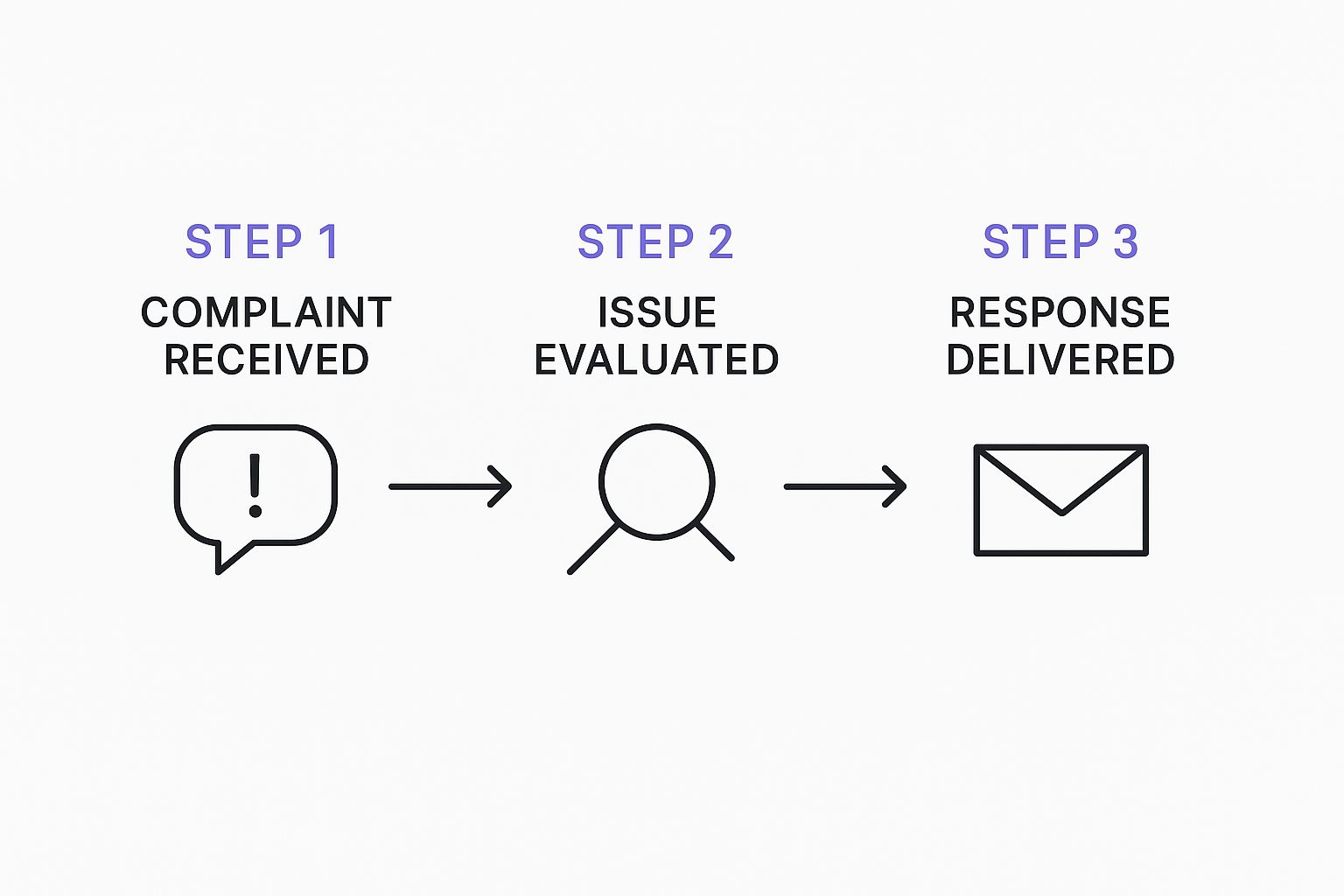Why Most Companies Completely Miss the Point With Complaints
Let's be honest: when an angry customer complaint lands in your inbox, the first instinct is to put out the fire as quickly as possible. Most companies run on a “solve and close” mentality. The goal is to fix the immediate problem, mark the ticket as resolved, and get on with the day. While this feels efficient, it completely misses the massive value hiding inside that customer's frustration. It treats a complaint as a nuisance to be swatted away, not as the priceless business intelligence it actually is.
This reactive mindset is a huge missed opportunity. A customer who takes the time to complain is essentially giving you a free gift—they’re showing you a crack in your business armor. While 91% of unhappy customers will just leave without saying a word, the ones who speak up are pointing directly to where you need to improve. Ignoring this feedback is like hearing a smoke alarm, but instead of looking for the fire, you just replace the battery.
The True Cost of a Bad Experience
The damage from a poorly handled complaint goes far beyond one lost customer. Negative experiences create a powerful ripple effect that can quietly eat away at your brand's reputation and bottom line. When a customer feels ignored or brushed off, they don't just disappear; they talk. In fact, after a poor service interaction, the average American customer tells 15 other people about it. This word-of-mouth spreads like wildfire online, poisoning the well for potential customers and tarnishing your image. You can explore more about these complaint management statistics to see the full impact.
This damage isn't just external. Internally, a constant stream of unresolved issues is a fast track to team burnout. Your support staff gets stuck in a demoralizing loop of appeasing angry customers, never feeling empowered to fix the real, underlying problems.
The Mindset Shift: From Nuisance to Goldmine
The companies that truly master how to handle customer complaints have made a fundamental shift in their thinking. They don't see complaints as problems; they see them as opportunities. Each complaint is a free consultation from the people who matter most: your customers.
Here’s what that shift looks like in practice:
- From Problem to Insight: A complaint about a late shipment isn't just one customer's headache; it's a data point highlighting a potential weakness in your logistics chain.
- From Critic to Advocate: Customers whose issues are resolved quickly and with real empathy often become your most loyal advocates—sometimes even more loyal than customers who never had a problem in the first place.
- From Cost Center to Profit Driver: When you start viewing your support team as a source of business intelligence, they stop being a "cost center" and become a crucial driver of product improvement, customer loyalty, and, ultimately, profit.
Building a Complaint System That Actually Captures Everything
To really get a handle on how to handle customer complaints, you first have to hear them. The tough truth is that for every customer who actually complains to you, another 24 stay silent and just take their business somewhere else. That means most companies are flying with a huge blind spot. The answer isn't to just wait by the phone; it's about building an accessible, multi-channel system that makes it simple for customers to share what's on their mind.
A solid intake system meets customers right where they are. Think about a small e-commerce brand that's big on social media. If their only complaint channel is a buried email address on their website, they’re missing tons of chances to fix issues that pop up on their Instagram or Facebook pages. A truly effective system pulls all these touchpoints—from live chat and email to social media DMs—into one unified workflow. This ensures no message, public or private, gets lost in the shuffle.
The following chart shows the basic journey of a complaint, from the moment it comes in to its final resolution.

This model makes it clear: every complaint, no matter where it comes from, needs to go through the same evaluation and response process to keep things fair and efficient.
To help you decide which channels are right for your business, here's a breakdown of the most common options.
Complaint Channel Comparison: Finding the Right Mix
Compare different customer complaint channels based on resolution speed, customer preference, and resource requirements.
| Channel | Average Resolution Time | Customer Satisfaction | Resource Cost | Best Use Cases |
|---|---|---|---|---|
| Phone/Live Chat | 5-10 minutes | High (Immediate) | High | Urgent, complex issues that need a back-and-forth conversation. |
| 12-24 hours | Medium | Medium | Detailed, non-urgent issues that require documentation or investigation. | |
| Social Media | 1-6 hours | Varies (Public) | Medium | Quick-response issues, public brand image management, and redirecting to private channels. |
| Help Center/Forms | 24-48 hours | Low-Medium | Low | Standardized, common problems where a structured data intake is helpful. |
Ultimately, the best approach is a blend. Relying on just one channel creates friction, while offering multiple options shows customers you're ready and willing to listen, wherever they choose to speak up.
Recognizing the Unspoken Complaint
Beyond just setting up channels, your frontline team needs to be trained to spot "disguised" complaints. These aren't direct "I'm unhappy" statements but subtle clues tucked into everyday conversations. For example, when a customer asks, "Is this supposed to take so long to set up?" they're not just looking for information—they're signaling frustration with the product's ease of use.
Training your team to catch and log these moments is a game-changer. You can create a simple way to track them:
- Product Friction: Comments about a feature being difficult to use.
- Expectation Mismatch: Questions that show the marketing promise didn't quite match the reality.
- Process Hurdles: Remarks about slow shipping or a confusing checkout experience.
This approach turns your support team into an active intelligence-gathering unit. By logging these small, seemingly minor issues, you can spot patterns before they blow up into major, public complaints. Tools like FlowGent AI can automate this by scanning conversation transcripts for keywords and sentiment, making sure every bit of feedback is captured without extra manual work. This organized method not only streamlines your response but also makes the whole process of raising a concern feel more welcoming for the customer, encouraging them to share valuable insights instead of just walking away.
Mastering the Critical First Conversation

The first few minutes you spend with an unhappy customer are a massive fork in the road. One path leads to a stronger, more loyal relationship; the other leads to a lost customer and negative word-of-mouth. This initial interaction isn’t just about damage control. It's your best chance to prove that you genuinely care, which is often what customers want even more than an immediate fix.
The goal here is a concept known as first-contact resolution. It’s so important that some studies show 67% of customer churn could be avoided if companies solve issues on the very first try. When customers have to explain their problem over and over, their frustration multiplies, making a good outcome feel impossible. You can see more data on how customer service statistics highlight the need for efficiency on Zendesk.com. This really drives home the need to make that first conversation count.
The Art of Listening and De-escalating
When a customer is upset, your first job isn't to solve the problem—it's to listen to it. This means active listening, not just waiting for your turn to talk. The key is to make them feel heard and understood.
Let's say a customer is furious because their custom-printed T-shirts arrived with the wrong colors. Instead of immediately jumping to solutions, your first words should be packed with empathy and validation.
A good response might sound something like this:
"Thank you for letting me know about this—I can only imagine how frustrating it must be to open that box and see the colors aren't what you were expecting, especially with an event coming up. I want to fully understand what happened so I can make this right for you. Could you tell me a bit more about which colors seem off?"
This one response accomplishes several things at once:
- It validates their feelings: Using phrases like "I can only imagine how frustrating that is" shows you get it from their perspective.
- It takes ownership: Saying "I want to make this right" instantly shifts the dynamic from a conflict to a partnership.
- It gathers information naturally: Asking for more details shows you're engaged and need specifics to find the correct solution.
Building Trust Through Transparency
Once you’ve listened, the next move is to clearly explain what you're going to do. Vague promises like "I'll look into it" are a recipe for more frustration because they create uncertainty. Be specific about the immediate next steps, even if you don't have the final answer yet.
A much better, trust-building approach would be:
"Okay, based on what you've told me, it sounds like there was a mix-up in our printing queue. I'm going to pull up your original order file right now and compare it with the production notes. This will take me about two to three minutes. Can you hold for a moment while I do that?"
This tells the customer exactly what you’re doing, why you’re doing it, and how long it will take. This level of transparency is essential for de-escalation because it gives the customer a sense of control and progress. Mastering this conversation is a cornerstone of great service, and you can learn more about how these interactions improve customer satisfaction in our guide. By handling this first touchpoint with care, you turn a potential disaster into a display of competence and empathy.
Crafting Solutions That Actually Solve Problems

After you’ve truly listened and grasped the customer's issue, it's time to find a genuine solution, not just slap on a conversational bandage. A cookie-cutter response, like the all-too-common "we're sorry for the inconvenience," can feel just as hollow as being ignored. A real resolution is personal; it takes into account the customer’s history with your brand, the specific problem they faced, and how it affects your business.
This is where empowering your team becomes a game-changer. When a support agent has the authority to issue a refund or offer store credit on the spot, they can turn a negative experience around in minutes. Research shows that customers who have a complaint handled in under 5 minutes are often willing to spend more on future purchases. This kind of speed transforms a moment of frustration into a powerful display of trust and efficiency, sidestepping the dreaded escalation loop where a customer repeats their story to multiple people, getting angrier by the minute.
When Does Compensation Make Sense?
Figuring out the right remedy is more of an art than a science. It’s not always about throwing money at the problem. A sincere, well-timed apology can be incredibly effective. In fact, studies show that 45% of customers are willing to retract a negative review after receiving a heartfelt apology, compared to only 23% who were offered compensation alone.
But sometimes, a tangible fix is the only way forward. Here’s a simple framework I use to decide on the best course of action:
- For a process failure (like a late shipment): A genuine apology paired with a small, unexpected gesture often does the trick. Think a discount on their next purchase. This acknowledges the mistake and nudges them toward another, hopefully positive, experience.
- For a product failure (like a defective item): This one's straightforward—a full replacement or an immediate refund is the only answer. The goal is to make the customer whole again as quickly and painlessly as possible.
- For a severe service failure (like a rude employee or a major screw-up): This calls for a multi-layered response. It might start with a personal apology from a manager, followed by a complete resolution of the original issue, and finally, meaningful compensation to acknowledge the frustration and emotional toll it took on the customer.
The key is to match the solution to the severity of the problem. Your goal should always be to provide a remedy that feels fair and proves you value their business beyond just a single transaction. If you're looking for more specific ways to handle tough feedback, checking out some effective negative review response examples can provide some great inspiration.
Following Up Without Being Annoying
Just because you’ve marked a ticket as "solved" in your system doesn't mean the customer feels the same way. The conversation isn’t truly over, and this is where so many companies drop the ball, missing a huge chance to build some serious loyalty. A thoughtful follow-up is the secret weapon that turns a one-time fix into a lasting positive memory. It shows you care about the customer, not just about closing a ticket.
The key is to make the follow-up feel genuine, not like another automated task on a checklist. Research shows that almost 70% of customers leave a company because they feel the business is indifferent to them. A simple, well-timed message can completely change that perception. This follow-up transforms the interaction from a transactional problem-fix into a relational touchpoint.
Smart Follow-Up Timing and Methods
Timing is everything. Jumping in too soon can feel intrusive, but waiting too long makes your message seem like a lazy afterthought. The sweet spot often depends on what the original complaint was about.
- For quick fixes: If you helped someone update their billing info, a follow-up email a day or two later asking if everything looks correct is perfect. It’s a low-effort way to confirm the resolution and close the loop for real.
- For product issues: Let's say you sent a customer a replacement part. You should wait until a few days after it was scheduled to arrive. A message like, "Hi Alex, just wanted to check in and see if the new widget arrived safely and is working as you expected," shows you’re actively tracking the outcome.
- For complex or emotional issues: This is where you can really shine. A personal check-in from a team lead or manager a week later can have a massive impact. This elevated level of care demonstrates that their issue was taken seriously across the entire company.
Gathering Feedback That Actually Helps
Your follow-up is also the perfect time to gather useful feedback. Don't just ask, "Are you satisfied?" Instead, ask open-ended questions that invite a real response. For example, try something like, "Now that you’ve had a chance to use the solution, is there anything we could have done to make the process smoother for you?"
This kind of question does more than just gauge satisfaction; it uncovers insights that can help you refine your entire support process. By treating each complaint as part of a longer conversation, you're not just handling issues—you're nurturing the entire customer experience. To see how these individual touchpoints fit into the bigger picture, you can check out our guide on customer journey orchestration.
Mining Your Complaints for Business Gold

Once a customer complaint is resolved, it’s tempting to breathe a sigh of relief and just move on. But doing that is like finding a gold nugget and tossing it back in the river. Every single customer complaint, no matter how frustrated, holds more practical business intelligence than you'd get from most expensive market research reports—you just need to know where to look.
The secret is to stop viewing complaints as isolated fires to put out and start treating them as valuable data points. When you log every issue, you can start connecting the dots. One person complaining about a confusing checkout process is a minor hiccup. Ten people complaining about it in the same week? That’s a critical flaw that is actively costing you sales. This is where robust customer interaction analytics come into play, helping you spot the trends that are completely invisible when you only handle issues one by one.
From Data Points to Actionable Insights
Just collecting complaints isn't enough; you have to organize them to understand the story they're telling. A simple but effective way to do this is by creating specific tags that your team can apply to every ticket or interaction.
This doesn't need to be complicated. Start with a few key categories:
- Product Flaws: Use this for any feedback related to features that aren't working as they should or are difficult to use.
- Process Friction: Tag issues that come from your operations—problems with shipping, billing errors, or a clunky return process.
- Service Gaps: This is for feedback about your team, like slow response times or agents who lacked the right information.
- Expectation Mismatch: These are crucial. Tag complaints where what you promised in your marketing didn't quite line up with the customer's actual experience.
Once you start tagging, you can build a dashboard that gives you a real-time health check on your business. Suddenly, your support team transforms from a reactive problem-solving unit into a proactive business intelligence hub. These insights give you hard evidence to guide decisions in product development, marketing, and staff training.
To really get a handle on what's happening, you need to track the right metrics. A dashboard can help you visualize performance and see where the real problems lie.
| Metric | Target Range | Business Impact | Tracking Method | Improvement Actions |
|---|---|---|---|---|
| First Contact Resolution (FCR) | 75-90% | High FCR reduces customer effort and boosts satisfaction. Low FCR means customers are getting frustrated and your team is inefficient. | CRM/Helpdesk analytics (Count tickets resolved in one interaction / Total tickets). | Improve agent training, update knowledge base, empower agents with more autonomy. |
| Average Handling Time (AHT) | 5-7 minutes (varies by industry) | AHT reflects agent efficiency. If it's too high, it could mean processes are complex or agents lack training. | Tracked via your contact center or helpdesk software from conversation start to end, including wrap-up time. | Streamline workflows with AI, provide better tools, identify and automate repetitive tasks. |
| Complaint Category Volume | <5% of total interactions | Shows where your biggest pain points are (e.g., product vs. shipping). A spike in one category is an early warning sign. | Use tags in your helpdesk software (like Zendesk or Freshdesk) and run reports on tag frequency. | Address root cause. A spike in "shipping damage" might mean you need to talk to your logistics partner. |
| Customer Satisfaction (CSAT) | >85% | Directly measures customer happiness with the resolution. It's a key indicator of loyalty and potential churn. | Send a post-interaction survey asking customers to rate their satisfaction on a scale (e.g., 1-5). | Analyze low scores for patterns, follow up with unhappy customers, and use feedback to coach agents. |
| Repeat Complaint Rate | <15% | High rates indicate that you're only providing temporary fixes instead of solving the underlying problem. | Track customers who log multiple tickets for the same issue within a 30-day period. | Conduct root cause analysis on repeat issues and implement permanent fixes in products or processes. |
This table isn't just a scorecard; it's a roadmap. By monitoring these numbers, you can spot trouble early and take action before small issues become business-threatening problems.
Proving the ROI of Great Support
Having this data is one thing; using it to drive change is another. It's much more powerful to approach leadership with concrete numbers. Instead of saying, "Customers seem unhappy with shipping," you can present a clear, data-backed case: "This quarter, we saw a 20% increase in complaints tagged 'shipping damage,' which correlates directly with our switch to a new packaging supplier."
This approach turns the support department from a perceived cost center into a strategic value driver. By addressing the root causes you uncover, you not only cut down on future complaints but also make your operations more efficient and build stronger customer loyalty. This is a core part of effective customer retention strategies. It proves that truly listening to what’s broken is the fastest way to build something better.
Creating a Company Culture That Welcomes Complaints
The single best way to get good at handling customer complaints is to stop seeing them as rare, unfortunate events. A business that truly puts customers first builds a culture where complaints are understood for what they are: valuable, free feedback. This isn’t just a job for the support team; it requires a company-wide shift in thinking, from the CEO all the way to the newest hire. It’s about creating an environment where employees aren’t afraid of bad news but are instead trained to welcome it as a genuine opportunity to improve.
This cultural change starts with training and empowerment. Every team member, whether they're in marketing, sales, or development, should have basic training in active listening and empathy. When a developer understands the real frustration behind a bug report, they’re far more motivated to fix it. When a marketing specialist sees feedback that an ad created a false expectation, they can adjust the message to prevent the same problem from happening again.
Fostering Accountability Without Blame
To make this mindset stick, you need systems that encourage improvement, not finger-pointing. When something goes wrong, the default reaction shouldn't be to look for someone to blame. Instead, the focus should be on the process.
Here’s how to build that kind of accountability:
- Recognize and Reward: Publicly celebrate employees who skillfully manage a tough complaint or are brave enough to bring a critical issue to light. This sends a clear message that finding and flagging problems is a positive contribution.
- Create Accountability Loops: Instead of asking, "Who messed up?" ask, "How did our process let this happen?" For instance, if you get several complaints about a confusing new feature, form a small, cross-functional team with people from support, product, and engineering. Task them with reviewing the feedback and proposing a fix. This makes improving the customer experience a shared responsibility.
- Democratize Feedback: Use a shared channel, like a specific channel in Slack or a dedicated section in your project management tool, to post and discuss complaint trends. This transparency ensures everyone sees the direct impact of their work on customer happiness.
This approach transforms your organization from a reactive one into a proactive, problem-solving machine. It builds resilience and makes your customers feel like partners in your success, encouraging them to bring issues directly to you instead of venting elsewhere.
Ready to empower your entire team with the tools to resolve issues instantly? Discover how FlowGent AI can automate resolutions and turn every employee into a support superstar.



